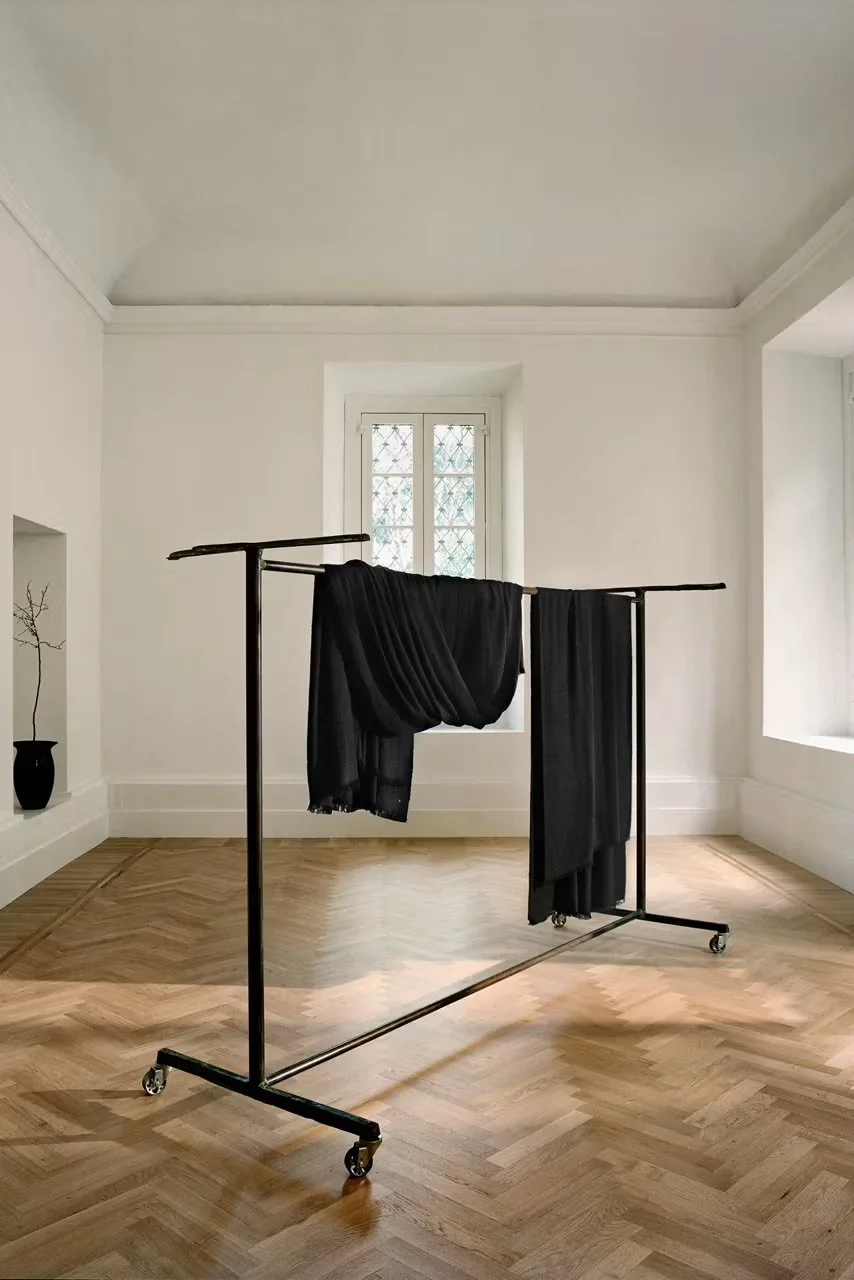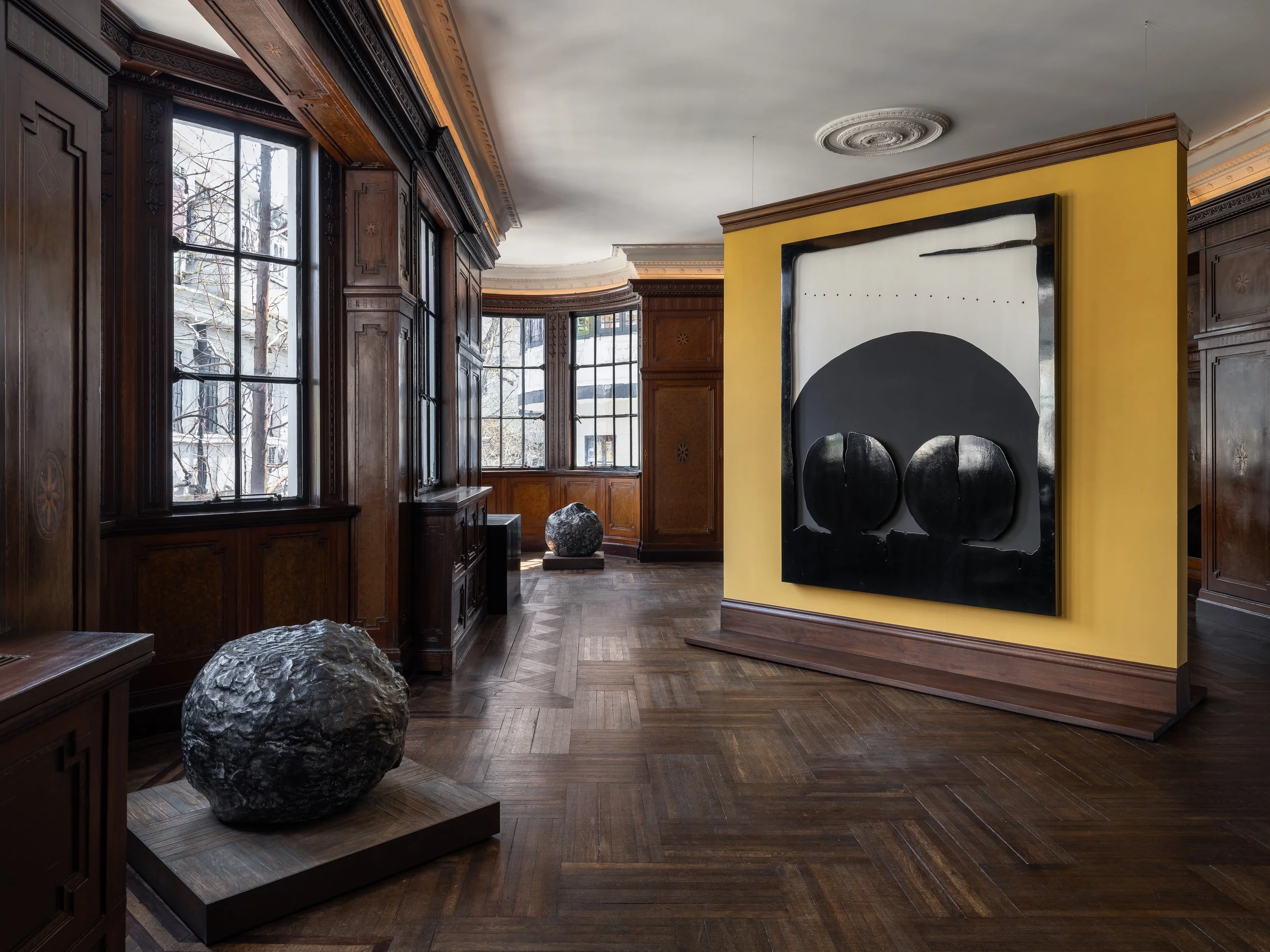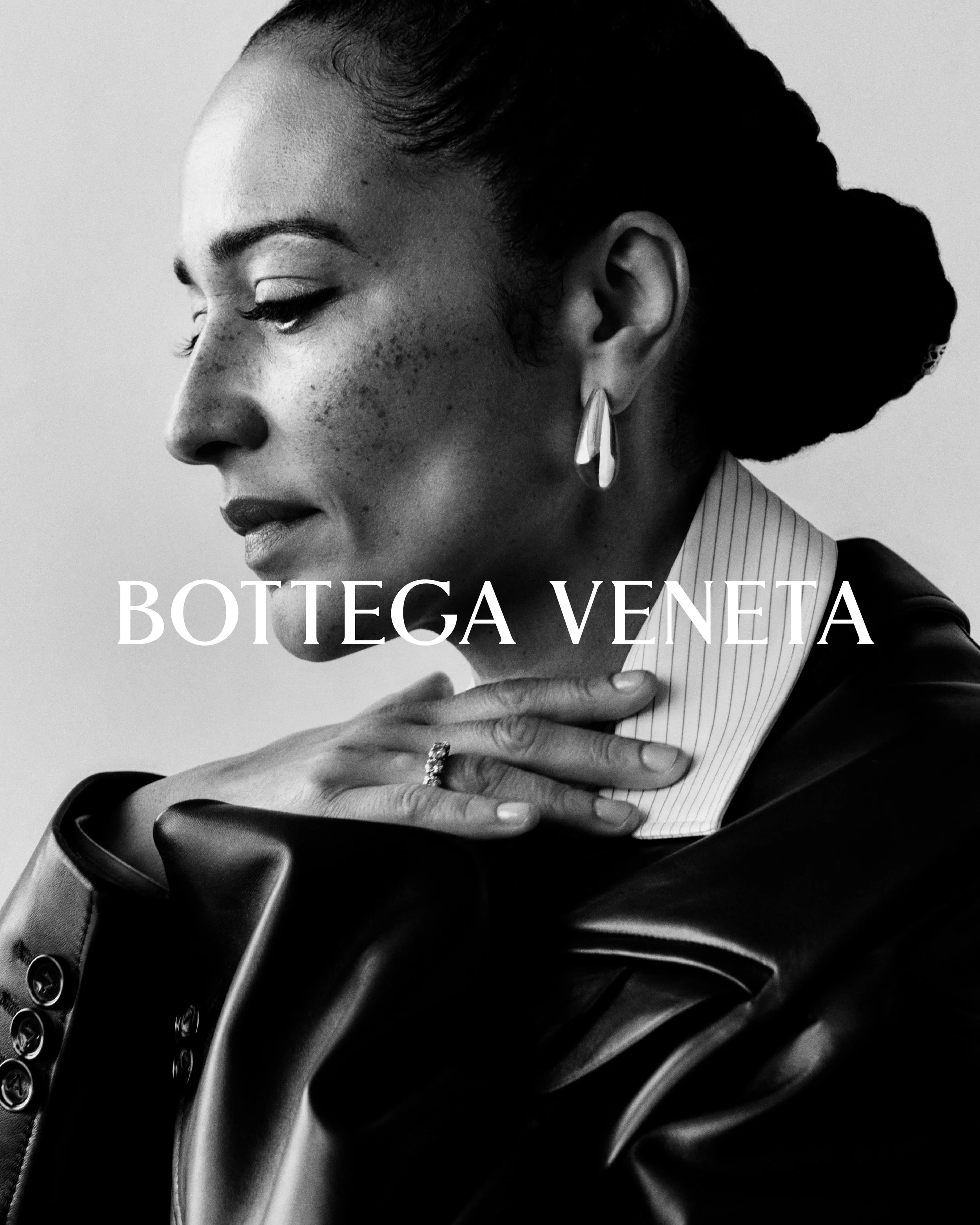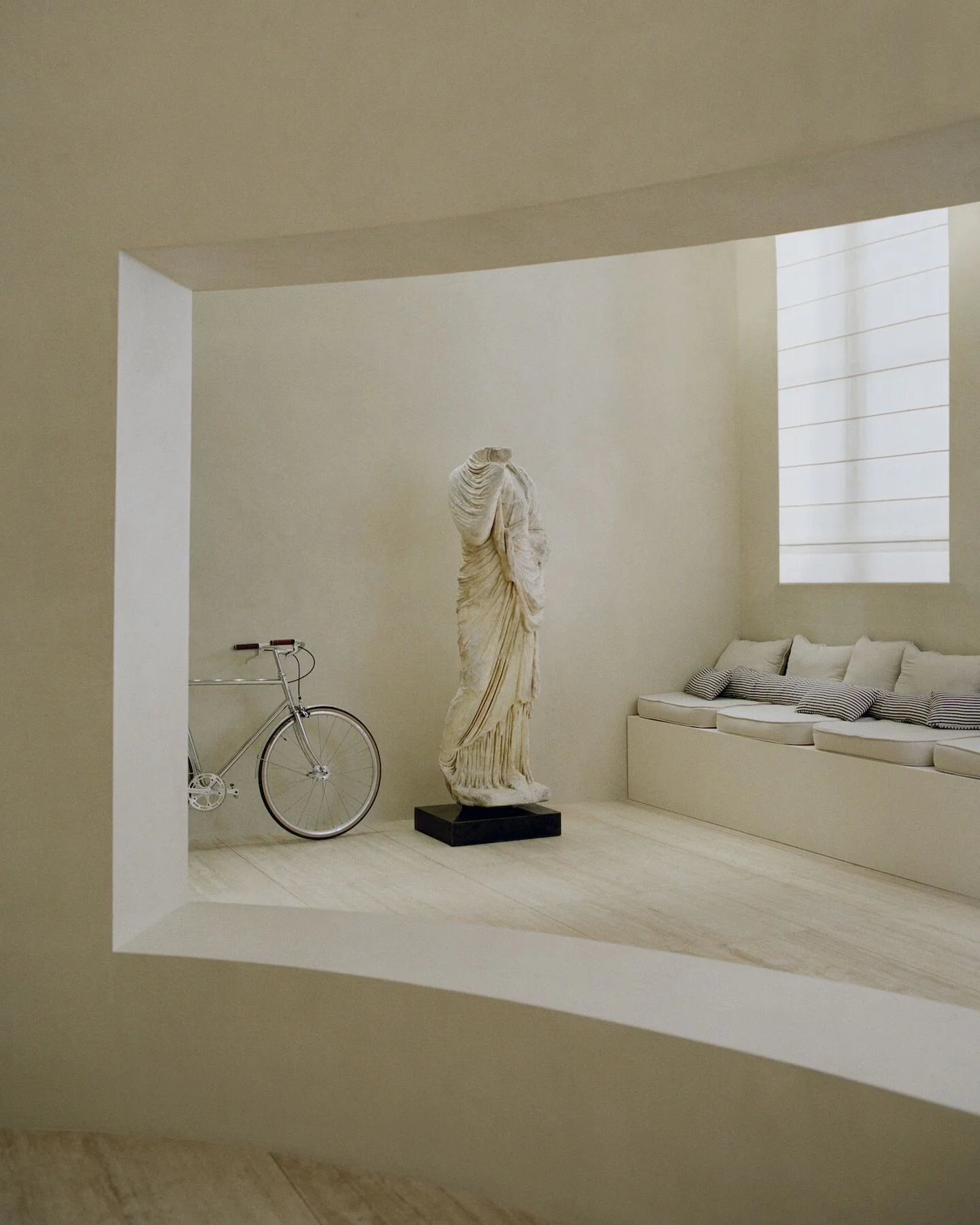Have Fashion Brands Become the Architects of Our Lives?
The Row’s presentation during Salone del Mobile. Courtesy of The Row.
Have Fashion Brands Become the Architects of Our Lives?
Luxury brands aren't just selling products anymore, they're orchestrating entire lifestyles. Valerie van Maarschalkerwaart questions how that influences our individual taste. Are we witnessing the democratization of culture, or are we sleepwalking toward intellectual conformity?
By Valerie van Maarschalkerwaart
A series of black-and-white photographs featuring only hands, accompanied by the phrase "Craft is Our Language," marked the debut of Bottega Veneta's new creative director, Louise Trotter. Not a new bag, but the stories of writers, poets, actors, and rappers took center stage in the campaign. It was a celebration of shared respect for artistry, a narrative that follows ideas rather than objects. While collaborations and fashion's expansion into the realms of arts and crafts are nothing new, the pace and scale have dramatically accelerated.
Today, luxury brands don't merely shape what we wear. They curate what we read, collect, and how we live. They build entire ecosystems, creating worlds we can inhabit through purchasing their products or attending their events. More than marketing, this signals an evolution in luxury and brand positioning. Where once curators provided the narrative while designers created objects, fashion houses now do both: they curate their universes and design the pieces that bring them to life.
Beyond their boutiques, luxury brands have infiltrated museums, art fairs, and cinema, positioning themselves as cultural arbiters rather than mere product manufacturers. This omnipresence raises critical questions: if brands begin orchestrating our lives at such a fundamental level, do we risk not only sartorial homogeneity but also intellectual conformity in how we think, what art we engage with, and how we consume culture at large? Or does this cultural democratization expand our aesthetic possibilities?
"Suddenly, everyone wants to be a lifestyle brand," notes Constance Govare, founder and creative director of Clqssique. This shift isn't driven solely by brand ambition. It's shaped by our evolving media landscape, where traditional gatekeepers between brands and consumers have dissolved. Media brands no longer hold exclusive control over brand narratives. Instead, brands can communicate directly with their audiences, creating endless opportunities to expand storytelling while consumers gain unprecedented access to the brands they love.
As luxury becomes more accessible, the next frontier lies in deepening relationships with the brands we love. Newer generations, especially, seek meaning over logos and experiences over ownership. Leila Fataar, consultant, founder of Platform 13, and author of Culture-Led Brands, explains that "global events have impacted consumer needs." This makes finding ways for brands to remain "culturally relevant" a "key business growth driver today," she continues. "A pretty piece is no longer enough," adds Marieke Meulendijks, co-founder and creative director of Amsterdam-based brand Róhe. For them, "luxury is about experience, not just the product."
Prada Rong Zhai is a restored 1918 mansion in central Shanghai, reopened by Prada in 2017. It now hosts cultural events and exhibitions curated by the brand. Courtesy of Prada.
Bottega Veneta’s Craft is Our Language campaign, featuring author Zadie Smith. Courtesy of Bottega Veneta.
This makes brand expansion attractive not only creatively but commercially. Brand ecosystems become strategic tools for building deeper consumer relationships across multiple touchpoints. "Brands are commercial entities, not art in the traditional sense," Fataar explains. This doesn't diminish their cultural impact, but it does mean that curatorial choices carry commercial weight.
It creates a paradox: the most commercially successful cultural campaigns often emerge from the most authentic places. Róhe, for example, has always approached their work "from a place of intuition rather than strategy, allowing ideas to take shape through process, dialogue, and lived experience."
The distinction between authentic expansion and opportunistic trend-chasing lies in coherence and consistency. "When a brand's evolution is anchored in its founding ethos—a continuity of intention and idea—it reads as philosophy, not marketing strategy," Govare explains. "These brands don't ask what they can sell next, but what they stand for." Both Fataar and Govare agree that merely jumping on trends or responding to market briefs won't sustain beyond a season. For expansion to resonate, it must arise from something deeper than market research, stemming from a brand's natural desire to share its worldview.
If brands can detect consumer needs better than consumers themselves, however, there's a risk of cultural flattening. "I see it daily in New York: people feel they need an iced coffee in hand, leggings, the 'right' sneakers, and a Birkin to belong. It feels like a uniform of belonging, not an individual perspective," Govare observes.
This individual consumer perspective needs space to flourish. When a brand's expansion stems from sincere passion and comes from a place of "obsession and specificity," they can create worlds that "influence without erasing personality," Govare explains. Accumulation born from genuine passion can spark personal taste development. In this case, brands offer frameworks within which creativity can grow, rather than serving uniforms.
How brands create narratives, offer platforms, and express their vision determines their authenticity as lifestyle curators. "A true brand world feels lived-in, not staged," Govare notes. When commercialism becomes obvious, the brand fails. It must feel like a "continuation rather than an expansion."
Róhe’s headquarters in Amsterdam. Courtesy of Róhe.
Lemaire’s in-store exhibition featuring the work of artist and long-term collaborator Carlos Penafiel. Courtesy of Lemaire.
Brands like Prada and Issey Miyake excel at building cultural ecosystems. For years, they've created space for intellectual stimulus and conversation. Issey Miyake has opened several galleries in Japan, while Prada built their own cultural institution. Fondazione Prada transcends typical museum boundaries—it enables education and art while respecting cultural heritage. Their continued curiosity leads to projects like a curated Arte Povera exhibition in Shanghai's landmark Rong Zhai, which they renovated themselves.
They offer more than clothing while remaining fashion brands. Issey Miyake's fall/winter presentation used Erwin Wurm's artworks to make audiences reconsider what clothing is and can be. The narrative and journey matter more than function. Similarly, Bottega Veneta's campaign created space for interaction—it was personal, about human touch, connecting to the brand's direct relationship with craftsmanship.
"Such campaigns only resonate when they make sense to both brand and consumers," Fataar notes. It's a push and pull between brands' expansion desires and listening to consumer needs. People already choose brands based on the "framework through which they view the world," Fataar notes. People are curators too.
The Jacquemus office. Courtesy of Jacquemus.
JW Anderson’s newly launched resort collection featuring objects next to ready-to-wear. Courtesy of JW Anderson.
"Ultimately, the question isn't whether a brand should expand, but why and how. At best, these worlds offer new ways of seeing, new frameworks. At worst, they flatten personal taste and curiosity into algorithmic alignment," Govare concludes.
The ultimate measure of this cultural shift isn't whether brands should expand into lifestyle curation, but whether they can do so without diminishing individual agency. When campaigns, curation, and expansion emerge from genuine intent rather than market opportunism, they create cultural value that extends beyond commercial success.
The central tension is this: as brands construct increasingly complete ecosystems, the risk of cultural homogenization grows. Yet when executed with integrity and diverse perspectives, brand curation can serve as a catalyst rather than a constraint. It offers frameworks for discovery, launching points for personal exploration rather than prescriptive lifestyle templates.
The future of luxury lies not in brands becoming totalitarian lifestyle architects, but in their ability to provide sophisticated tools for individual curation. The most successful will be those that inspire consumers to become their own cultural curators, using brand narratives as starting points rather than destinations. In this model, brands don't replace personal taste—they cultivate it.










